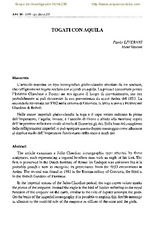Mostrar el registro sencillo del ítem
Togati con aquila
| dc.contributor.author | Liverani, Paolo | es_ES |
| dc.date.accessioned | 2010-04-05T12:45:17Z | |
| dc.date.available | 2010-04-05T12:45:17Z | |
| dc.date.issued | 1999 | |
| dc.identifier.issn | 1130-9741 | |
| dc.identifier.uri | http://hdl.handle.net/10396/2809 | |
| dc.description.abstract | The article examines a Julio-Claudian iconographic type attested by three sculptures, each representing a togated headless man with an eagle at his feet. The first is preserved in the Dutch Institute of Rome: its findspot was unknown but it is probably possible now to recognise its provenance from the 1853 excavations in Ardea. The second was found in 1982 in the Roman colony of Gravisca; the third is in the Boboli Gardens of Florence. In the imperial statues of the Julio-Claudian period, the toga capite velato marks the pietas of the emperor. Instead the eagle is the bird of Jupiter referring to the royal function of the emperor on the earth, similar to the role of Jupiter amongst the gods. On the basis of the imperial iconography it is possible to explain this double message as allusion to the twofold role of the emperor as officer of the state and the gods. | en |
| dc.description.abstract | L' articolo esamina un tipo iconografico giulio-claudio attestato da tre sculture, che raffigurano un togato acefalo con ai piedi un aquila. La prima é conservata presso 1' Istituto Olandese a Roma: ne era ignoto il luogo di rinvenimento, ma ora probabilmente si pub ricostruire la sua provenienza da scavi Ardea del 1853. La seconda fu rinvenuta nel 1982 nella colonia di Gravisca, la terza si trova a Firenze nel Giardino di Boboli. Nelle statue imperial¡ giulio-claudie la toga e il capo velato indicano la pietas dell' imperatore, 1' aquila, invece, é l' uccello di Giove e allude alla funzione regale dell' imperatore sulla terra simile al ruolo di Giove tra gli dei. Sulla base del complesso delle raffigurazioni imperial¡ si può spiegare questo doppio messaggio come allusione al duplice ruolo dell' imperatore funzionario dello stato e degli dei. | es_ES |
| dc.format.mimetype | application/pdf | es_ES |
| dc.language.iso | ita | es_ES |
| dc.publisher | Universidad de Córdoba, Área de Arqueología | es_ES |
| dc.rights | https://creativecommons.org/licenses/by/3.0/ | es_ES |
| dc.source | Anales de Arqueología Cordobesa 10, 263-276 (1999) | es_ES |
| dc.subject | Arqueología | es_ES |
| dc.subject | Época julio-claudia | es_ES |
| dc.subject | Escultura | es_ES |
| dc.subject | Antigüedades romanas | es_ES |
| dc.title | Togati con aquila | es_ES |
| dc.type | info:eu-repo/semantics/article | es_ES |
| dc.relation.publisherversion | https://www.uco.es/ucopress/ojs/index.php/anarcor/index | es_ES |
| dc.rights.accessRights | info:eu-repo/semantics/openAccess | es_ES |

